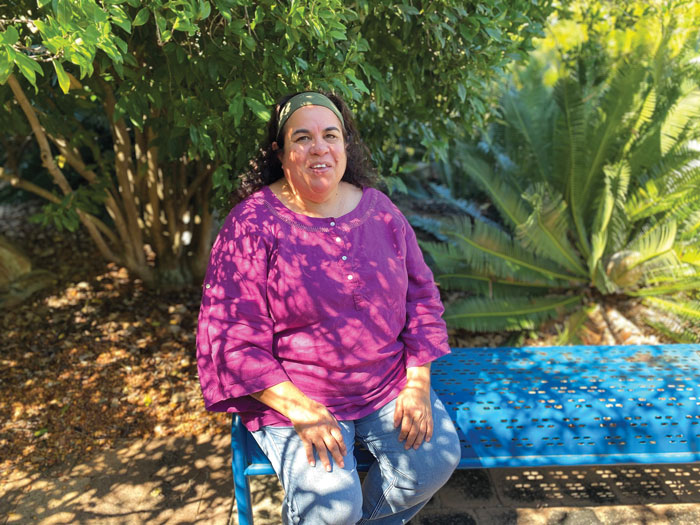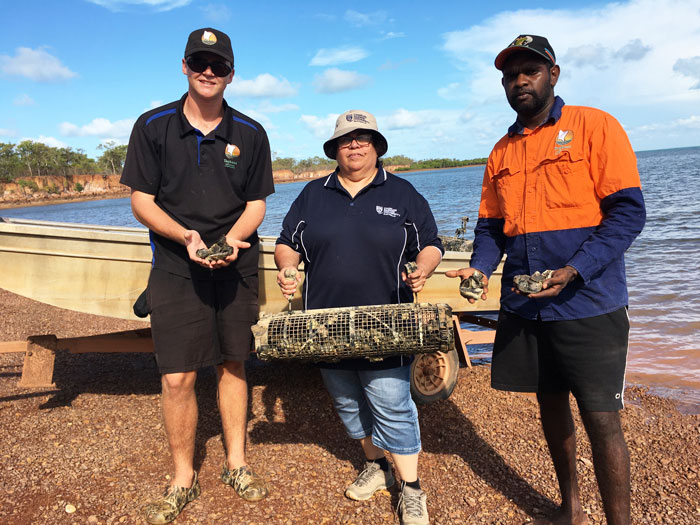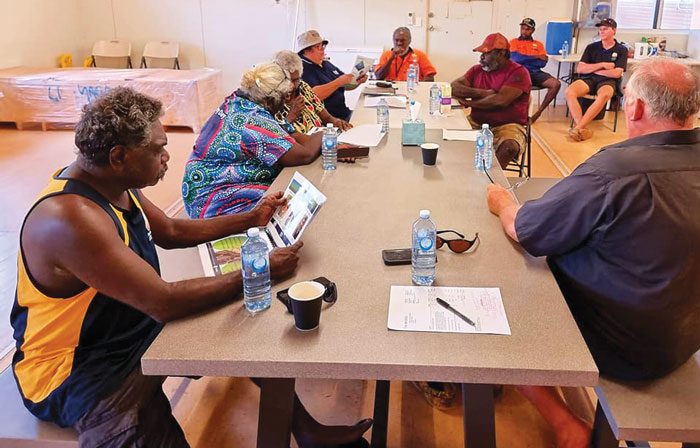Indigenous leadership and communication are integral to tropical rock oyster research, creating new ways to discuss the manageable “invisible risks” that Vibrio bacteria pose to an emerging industry
By Catherine Norwood
Scientific and commercial momentum is building to establish a tropical rock oyster industry, and Cynthia Coyne finds herself in a unique position at a critical time in the industry’s development, communicating research to industry and community stakeholders.
Coyne is a communications, extension and adoption (CEA) project leader with Charles Darwin University, which is leading a new FRDC-funded project that aims to support food safety in this emerging industry across northern Australia.
Launched in March 2021, the project focuses on Vibrio bacteria that occur naturally in the marine environment. It aims to identify Vibrio species in tropical oysters, optimising bacterial tests for routine use and identifying the best storage, transport and shelf life conditions that ensure high food safety standards.

Coyne’s appointment to the CEA role is part of the proactive approach the FRDC is taking to develop opportunities on two fronts. One is to provide the research needed to help establish new aquaculture industries. The other is to provide opportunities for Indigenous environmental graduates to work in fisheries research. Coyne’s role is to produce plain language fact sheets and synthesis reports about the tropical rock oyster research project and to communicate the science to a range of stakeholders, especially Indigenous industry stakeholders such as the Warruwi Oyster farmers of the Yagbani Aboriginal Corporation.
Coyne is a First Nations Australian woman who was born and grew up in the Northern Territory. She has sociocultural and kinship affiliations to the Jukun-Yawuru people of Broome and the Jaru people of the East Kimberley.
She brings to the project her training in anthropology, Indigenous art, environmental science and environmental management, as well as experience and leadership in Indigenous stakeholder engagement across northern Australia. This includes a new approach and perspectives on communication initiatives that expand on typical scientific views and objectives.
Project partners represent the diversity of interests in this emerging sector. They include Maxima Rock Oyster Company in Western Australia; Bowen Fresh Oysters, a family operation in Queensland; and Yagbani Aboriginal Corporation and its Indigenous oyster farmers on Goulburn Island, in the Northern Territory.
All are represented on the project steering committee, along with the FRDC and representatives from state and territory governments responsible for shellfish quality assurance.
Coyne says this project aligns with her own efforts to support Indigenous cultural and natural resource management on Country, providing livelihoods, benefit-sharing and economic stability for place-based local Indigenous people.
There is significant potential for Indigenous communities to become involved in tropical rock oyster aquaculture. This is highlighted by Yagbani Aboriginal Corporation’s involvement in the project; it is nearing the launch of commercial farming on Goulburn Island.
In WA, the Murujuga Aboriginal Corporation is a partner with Maxima Rock Oyster Company, which has a pilot-scale rock oyster farm in the Dampier Archipelago in the Pilbara region. This pilot-scale farm was supported by the FRDC and it is now working with the Cooperative Research Centre for Developing Northern Australia (CRCNA), which is coordinating broader research and development needed to underpin the emerging industry.
Other research in the CRCNA project is identifying the best species for aquaculture in different regions. Native Blacklip Rock Oysters (Saccostrea spp.) are the primary focus for cultivation. The Darwin Aquaculture Centre is undertaking hatchery trials to optimise larval settlement procedures and improve nursery culture. The ultimate aim is to provide industry with a consistent, commercial supply of spat for growout.

Vibrio knowledge gaps
Indigenous communities have been dining on rock oysters for millennia; the establishment of farming for northern species is set to extend these delicacies to new audiences. However, collecting and eating fresh rock oysters with family and friends in local communities is not the same as farming them in bulk to harvest and transport long distances to market.
For Coyne, there is a balancing act in the communications, to have the “invisible” risk of naturally occurring Vibrio bacteria in the water understood clearly, without raising undue alarm with producers or consumers.
Her role with project stakeholders, particularly Indigenous partners, will support their participation as active contributors to the research. For instance, for the Warruwi people on Goulburn Island involved in the Yagbani commercial aquaculture initiative, this will involve collecting oysters and doing water quality testing with support from the team at Charles Darwin University and the Darwin Aquaculture Centre.
The project’s lead investigator, Karen Gibb, says Vibrio bacteria occur naturally in the marine environment. They can be present in harvested shellfish and some Vibrio species may cause illness if the shellfish are eaten uncooked, as is often the case with oysters.
The presence of Vibrio species is an emerging challenge for all oyster producers in Australia.
“We know there is a high diversity of species in the tropics. More than 40 have already been identified as commonly occurring in northern waters, but we think most pose no risk to people,” explains Gibb.
“Tropical rock oysters have co-evolved with vibrios. We are at the very early stages of understanding their relationship and we need more information about the baseline presence of Vibrio in these oysters and whether the Vibrio community changes with the season.”
She says when it comes to quality control, it will be important that testing protocols are sophisticated enough to identify particular Vibrio species that may pose a health risk, rather than just registering the presence of any Vibrio species.
The three-year project will gather more detail on the Vibrio species found in northern oyster-growing areas and the potential toxicity of different species. Gibb and colleague Anna Padovan have been working with Vibrio bacteria for more than a decade, and their work has shown that more molluscs are positive for Vibrio in the wet season. Extending this knowledge to oysters and the Vibrio community will provide a clearer understanding of seasonal baselines, which will help producers make informed decisions.

Quality control
Gibb’s project will also better address the gaps in knowledge about how Vibrio species in tropical rock oysters respond to storage and transport temperatures. “We want to provide data and informed advice on the best post-harvest storage and transport temperatures and to assess shelf life of tropical rock oysters at realistic storage temperatures.”
Gibb says this information will be crucial for managing supply chains to ensure tropical rock oyster are safe for consumers. And regionally relevant Vibrio risk strategies can be developed to support this new sector and ensure an “exemplary reputation”, right from the start, giving access to premium markets.
In a related project, Sarah Ugalde at the University of Tasmania is working to address other food safety issues related to oyster aquaculture in northern Australia. As a high-risk food group, there are stringent regulations associated with risk management of oysters in Australia. Ugalde’s project will look to adapt the successful strategies used by southern states, listed in the Australian Shellfish Quality Assurance Program Manual, to the context of northern Australia.
Both projects align with the work conducted by the FRDC’s food safety platform, SafeFish, which is a joint project between the University of Tasmania and the South Australian Research and Development Institute (SARDI) led by Alison Turnbull.
SafeFish has been raising awareness and building capability in Vibrio risk management in Australia. A recent three-part Vibrio Webinar Series explains the science of Vibrio bacteria, outlines practical actions oyster farmers can take to reduce risk, and begins the discussion around the regulatory guidance needed in Australia.
More information
Cynthia Coyne, cynthia.coyne@cdu.edu.au
Karen Gibb, karen.gibb@cdu.edu.au
SafeFish





